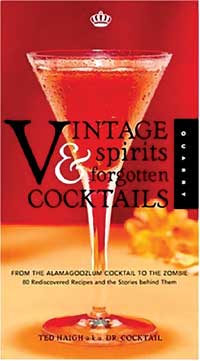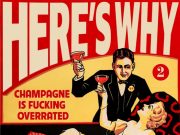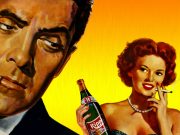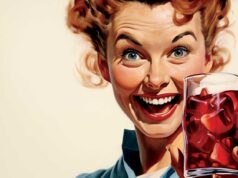Dr. Cocktail knows what you’re drinking.
And he wishes you would pause for a moment and reconsider that vodka/ Kool-Aid combo you’re throwing together, and perhaps opt for something a little more, shall we say, sophisticated.
Don’t get mad. If anyone has a right to slap the Kool-Aid out of your hand, it’s Ted Haigh, aka Dr. Cocktail. Because while he may make his living designing graphics for such feature films as Oh Brother, Where Art Thou and Road To Perdition, the Doctor’s mind, heart, and soul belong to the cocktail.
Though his creations aren’t likely to terrorize any villagers, it’s easy to compare Haigh to another famous doctor: Baron Von Frankenstein. Much as the Baron excavated, reassembled and reanimated the dead in hopes of creating a superior being, Haigh digs through vintage cocktail guides, scours the Earth for archaic liquors and mixers, then spends long days at the bar, tweaking the recipe, trying to make it even better than it was. Then, when the Doctor feels the libation is ready to reacquaint itself with the drinking public, he shocks it back to life with a good jolt of publicity. His recent book, Vintage Spirits and Forgotten Cocktails(Quarry Press) attempts a mass resurrection of sorts, presenting 80 lost cocktails he reckons are due a comeback.
Haigh has also enjoyed great success as an alconaut. Voyaging into uncharted territory, he has managed to create entirely new cocktails, some of which have landed on the pages of contemporary cocktail guides.
I caught up with Dr. Cocktail as he was pouring his first drink of the afternoon.
Modern Drunkard Magazine: When did your magnificent obsession with the cocktail begin?
Doctor Cocktail: I was about 14 at the time. I was a total bookworm, the kind of misguided kid who imagined the bullies at school would like me if I used better terminology. I was exploring my father’s library, and on a high shelf I found a 1940s reprint of Patrick Gavin Duffy’s The Official Mixer’s Manual. At that point all I knew about drinking was essentially from the movies, because my parents weren’t drinkers. They were a glass of Port at Thanksgiving kind of people. So I looked at this book and thought, “This is the stuff they were drinking in The Thin Man. This is what W.C. Fields was getting drunk on.”
MDM: On and off the set.
DC: Right. And the names of the boozes fascinated me: the Forbidden Fruit liqueur, what the hell was that? And the cocktails: the Bosom Caresser, the Monkey Gland. What 14-year-old kid wouldn’t love it?
MDM: So the forbidden lure of the cocktail was strong.
DC: Very. Even before then, I saw some cowboy on TV drinking water out of his boot, so I got a cowboy boot and tried it. Once an empty vodka bottle came into my possession somehow, I must have been about nine at the time. I filled it with water and put a lot of pepper in it, figuring that was what liquor was, so inadvertently I created Vodka Peppar. Not a royalty to be found, but it’s true.
 MDM: What happened after you read Duffy’s book?
MDM: What happened after you read Duffy’s book?
DC: I filed it away. Eventually somebody introduced me to Dino Gold Labels—those long thin cigars—and Malt Duck. Malt Duck was kind of like Kool-Aid and beer mixed together. I hadn’t arrived quite yet. After high school the first cocktail I attempted was a Little Devil Cocktail: Cointreau, gin, and lime juice. Being at that impressionable age, I thought, “I can do better than they can.” I took a giant water glass and filled it with Rose’s Lime Juice and gin, and whatever kind of orange slurry I could find at the time. For years I collected horrible hangovers, then thought, “I can’t do this anymore.”
MDM: So it wasn’t exactly love at first taste?
DC: But it was. It was sweet, well, disgusting, but it was pleasant. Now realize , I was a classy drinker compared to my friends. They were all drinking ripple and MD 20/20. I wouldn’t touch anything less than a gallon jug of Gallo Hearty Burgundy. It was the minimum. After going through enough of those hangovers to last a lifetime, I gave it up for awhile. I did some traveling and basically grew up.
MDM: What heralded your astonishing comeback?
DC: When I moved to Los Angeles in 1990 I finally found the thing I had been searching for since I read that book: Kina Lillet. It was referenced in the Corpse Reviver and I had to come to LA to find it. I would have never gotten it in Virginia where I was born, they didn’t carry stuff like that at the ABC stores. The other problem was it was no longer called Kina Lillet, it was just Lillet. Once I realized that, I thought, “That’s great, I can finally make this.” Unlike my high school years when I just combined everything haphazardly, this time I—well, it might as well have been with lab equipment, I was so exact. And it was fantastic. It spun my head around. I was amazed how you could taste every ingredient, even after it was shaken.
MDM: And so arrived Dr. Cocktail. When do you reckon the first cocktail was thrown together? I know the word has been around since 1806, when the editor of the newspaper The Balance mentioned it.
DC: There were all kinds of mixed drinks before then. So, do you take it back to distillation, do you take it back to spicing wine? The drink that is a cocktail predated the term obviously. I’ll give you a new definition as to where cocktail came from: it was a morning drink. Anything drank in the morning in those days—it may have been called a Phlegm Cutter or a Mother’s Ruin. When asked what a cocktail was, The Balance editor defined it for all time as meaning a bittered sling — a spirit, water, sweetening and bitters.. The thing that made people really grab a hold of his definition was the bitters. The bitters, nobody really gets this, the thing that makes this really interesting, is there were no cocktail bitters then. There were no cocktail glasses or shakers, there were no cocktail bitters. People were going straight to their medicine cabinet and pulling out medicinal bitters and putting it in their drinks. This is another great argument for this having been a morning drink. Plus the fact the next published uses of the term cocktail over the next few years almost invariably said it is was drunk in the morning. Some of them said it obliquely; some of them said it directly. Once you figure that out, you can say it is the rooster heralding the early morning light of day. Either you have not gone bed to yet, and you need something to assuage your fevered brow, or you are waking up and you need something to assuage your fevered brow.
MDM: You’re saying the cock part of cocktail comes from the cock-a-doodle-do of a rooster greeting the morning.
DC: And the tail meaning the tail of your night or the tail of your hangover.
MDM: Speaking of morning cures, what ever happened to the types of cocktails once referred to as pick-me-ups? Now they’re pushing pills that supposedly do the same thing.
DC: Where’s the flavor in that? I was in New Orleans recently, graphic designing the film Ray. My first weekend off I wanted to try the great morning beverages, the Absinthe Suissesse, the Ramos Fizz, the Milk Punch. I had had them before, but not in New Orleans. I wanted to try a Gin Fizz, not a Ramos fizz, a real Gin Fizz. I went to a restaurant to try them and was starting to feel a little funny about drinking in the morning. Then a family came in and it was obvious that it was three generations. The kids were having gin and tonics, the father was having a Ramos fizz, the mother was having a Milk Punch, the grandmother ordered a dry martini, and the grandfather ordered a double scotch. It was 10:30 in the morning. You have to appreciate that. They were bright upstanding citizens. It was beautiful.
MDM: One of the unique possibilities of New Orleans is you can be in a restaurant at 7 a.m., still drinking from the night before, and a new crowd of morning drinkers will come in for their first drink of the day. The way the crowds mix is something to behold.
DC: It is perfectly natural there and the rest of the world should be that way. I will never forget one of the most potent things ever said to me. I was in Kansas City, doing Robert Altman’s Kansas City. I put out my feelers for old booze, at that point I was really into collecting old bottles of liquor. One of the locals got back to me and said, “Mr. Haigh, we would like to have you over to meet a dear friend of ours, she’s in her 80s, one of the richest people around and a native of Kansas City. She wanted to let you know she has a bowl of Fish House Punch in her refrigerator at all times.” I sat up in my seat and thought: My God, how could I possibly refuse this? When I got there she came out and said, “Mr. Haigh, I am so glad to meet you. I don’t know if you know me, but my husband was Walton Hall Smith.” My eyes just popped open and my mouth just fell to the ground.
MDM: Walton Smith, the author of Liquor, the Servant of Man?
DC: The same. Published in 1939. I reeled off a quote from the book, because I love that book, and she was stunned. We were getting along famously. She had a cocktail shaker that looked like it was out of the cartoons, it was as big as your upper torso. You had to wrap your arms around it to pour from the thing. We didn’t use it, although I tried to talk her into it. She said, “Mr. Haigh, I always have this Fish House Punch here, but I took out all the soft stuff and thought it would be better with just the liquor.” Everybody was shriveling up like a raisin while they were drinking it, but I said, “I will have another thank you.” It was wonderful. The thing that she said that totally galvanized me in my quest was, “Mr. Haigh, Walton and I were always heavy drinkers.” That was it. It was the way she said it. You didn’t feel like leaning forward and saying “Hey lady, you should stop that, it could be bad for you.” She said it so matter-of-factly, speaking with neither pride nor concern. It was just the way it was.
MDM: And shall forever be, if Modern Drunkard has its way. Isn’t it true you have a vendetta against vodka?
DC: It’s not about vodka, it’s about the Bureau of Tobacco, Alcohol and Firearm’s definition of vodka. In Eastern Europe vodka can be aged, nobody in Eastern Europe ever said vodka should be flavorless, that is something that we Americans are stuck on it. It sucks. The flavorlessness of vodka is what is going to turn a lot of the kids into alcoholics, not the good kind of alcoholics, the bad kind. If all they’re drinking is something that tastes like candy, what do you expect? They can’t even tolerate the bite of a good rye whisky.
MDM: The culture is definitely on the skids when drinkers don’t want to taste the alcohol in their cocktails.
DC: They cease to be cocktails at that point anyway.
MDM: Yes, but what to call them? As you mention in your book, the cocktail devoured all of the old drinks. There used to be the swizzle, the crusta, the flip, the punch—
DC: Each was a very specific thing. The cocktail was just one of many. Some of them are older than the cocktail. The crusta was a variation; the flip was two totally different things in its lifetime. In Colonial days it was a beer beverage in which they would stick a hot poker in it to heat up. By the late 19th century it had become something with an egg in it.
MDM: A flip is very hard to get at a bar, because of the salmonella scare.
DC: Those wimps. The only egg drink I won’t drink is a version of the Pousse Café, which is hardly worth drinking anyway. If you do it right, you’re just drinking a Whitman’s Sampler. The Pousse L’Amour has all those levels and right in the middle is a big raw egg. That’s where I draw the line.
MDM: Will have to give it a try. Which era do you consider the golden age of the cocktail?
DC: The golden age of the cocktail started at prohibition and WWII. You could put it a bit earlier, but during Prohibition there was no room for it to become golden, and before that it was just a morning drink. When Harry Johnson published the second bar guide ever, in late 1890s, it was pretty cool. Bartenders at that point took pride in choosing how long their bars were and how many cocktails they knew from memory. Even then cocktails were a specific thing, but by Prohibition everything became a cocktail. As I said in the book, it was cultural warfare.
MDM: Quite a few good drinks came out of Prohibition.
DC: In a roundabout way. A lot of good bartenders like Harry Craddock went to Europe. Everyone thinks Harry Craddock of the Savoy Cocktail Guide was English but he was an American. These expatriate Yanks went over there to ply their trade because suddenly in this country it was illegal. They produced some amazing things, and because the ingredients we have over here were not available over there, they produced some amazing new concoctions. The United Kingdom Bartenders Guild was turning out cocktails that put ours to shame, they were so good.
MDM: And if you were hanging out in Paris with the Lost Generation?
DC: I’d go to Harry’s American Bar. Harry also founded the IBF, the International Barfly Federation. This really got a lot of these cocktail hankerers together in a real way. It’s part bartending union, part cheering section, and part bartender. Paris or London were great hotbeds of activity. Of course, down in Cuba there were wonderful things done by Constantino Ribalaigua.
MDM: At the La Florida, where Hemingway drank.
DC: While Hemingway was drinking daiquiris at the La Florida Bar, down the street you could drink mojitos at the Sloppy Joe’s. There was all kinds of great stuff going on all over the place. So you see, most of the great cocktails during prohibition were not created here.
MDM: It’s an interesting parallel. All our great writers went overseas with the bartenders, naturally, and created an amazing body of literature. Not many good books came out of America while it was dry. Apropos of nothing, let me ask you this: is there a decent cocktail that can be made with mescal?
DC: You’d have to experiment. I think it’s easier to make a cocktail with mescal than it is to make a cocktail with Irish Whiskey. Mescal is like Scotch. Much better straight. An acquired taste is worth acquiring.
MDM: How do you feel about Tiki cocktails?
DC: I am a big fan of the entire range of Don the Beachcomber Tiki drinks. To me he was the king of the Tiki drinks. Jeff “Beachcomber” Berry is a friend of mine, he’s come over to my house and I’ve tested drinks out on him and he has tried Tiki drinks out on me. He has taste buds of gold. We have Tony Ramos bartending in LA, and he is probably the finest tropical drink bartender alive.
MDM: In your book there are a lot of pictures of old bottles of liquor, and I couldn’t help but notice that some of them appeared to have booze still in them.
DC: I have more antique booze than any bar you have ever walked in.
MDM: Do you ever drink that stuff?
DC: If I have three or more bottles, and if it’s any good, and I am the expert. I will open a bottle if it’s a special occasion and I will serve it to friends. I’ve got a bottle of 1947 Green River Rye open now that I am going to have to finish it at some point. Once the level starts getting below half I am just going to have to have a party. Otherwise it is just going to go, and you just can’t count on it staying. You have to appreciate it for what it is, and enjoy it. There is something to say for the wine people who always say you are going to drink that aren’t you? If you keep it sealed its fine, but if you open it you better drink it.
MDM: You mentioned the International Barfly Federation. There used to be a lot of drinking clans, do you foresee that coming back?
DC: To some extent it has, we have LUPEC.
MDM: LUPEC?
DC: Ladies United for the Preservation of Endangered Cocktails.
MDM: God bless those gals. What do your reckon is the most difficult cocktail to make? That’s worth making.
DC: Difficult can mean so many different things. The most difficult cocktail I bother to make is J.P. Morgan’s Alamagoozlum Cocktail.
MDM: From Charles H. Baker Jr.’s book.
DC: It is great.
MDM: Worth the effort?
DC: Absolutely.
MDM: Try ordering one in most bars and the bartender will try to strangle you. It seems to me a lot of bartenders act like they’re working at McDonald’s. They just crank out drinks like machines. The sense of professionalism and joy has gone to the wayside. Though occasionally you can find older bartenders, usually in hotels, that still possess a sense of professionalism.
DC: It’s true. Here in Los Angeles if you want an older bartender—this going to kill you— start drinking during the day.
MDM: I usually do.
DC: Right. I forgot who I was talking to. The older bartenders don’t want to drive at night, so they work the day shift. You can get some amazing drinks and even more amazing stories, if you’re willing to drink during the day. Sometimes you will find a kid who’s receptive to at least the iconographic concept of the classic cocktail. In that case you can start them from scratch and teach them the way they ought to be taught.
MDM: Someone should. Of all the forgotten cocktails, which would you most like to see make a comeback?
DC: The Blinker. It’s a terrible name. A lot of the old  cocktails suffered from terrible names. The original Blinker called for grenadine, but during the Colonial era, grenadine was often unavailable so they used raspberry syrup. This drink was two parts rye whiskey, and one part grapefruit juice (try not to use the pink shit) and about a bar spoonful of raspberry syrup. I recommend Smucker’s Raspberry Syrup, the kind you put on a mound of ice cream, not the kind you would put into coffee. If you do this with just those ingredients it is the most amazing cocktail.
cocktails suffered from terrible names. The original Blinker called for grenadine, but during the Colonial era, grenadine was often unavailable so they used raspberry syrup. This drink was two parts rye whiskey, and one part grapefruit juice (try not to use the pink shit) and about a bar spoonful of raspberry syrup. I recommend Smucker’s Raspberry Syrup, the kind you put on a mound of ice cream, not the kind you would put into coffee. If you do this with just those ingredients it is the most amazing cocktail.
MDM: Sounds rather sweet.
DC: It’s not, not when made correctly. It’s a lot of rye whiskey, it has a tinge of bitterness, but otherwise it’s tart with a hint of raspberry. This is an amazing drink. This is the one.
MDM: What drink do you always come back to?
DC: I come back to the straight flavors, the straight boozes. When I am looking for a variation, I begin to explore what can be added to them to create a complex sculpture of flavor. And that’s the truth.
MDM: You prefer cocktails where you can taste each flavor.
DC: I do.
MDM: What is the most common mistake an amateur mixologist makes? Besides over-pouring, as we drunks tend to do.
DC: You have to measure. Too many think canned fruit juice is the same as fresh squeezed, but there’s a huge difference.
MDM: What about the shaking technique?
DC: I am not a purist in the sense that it has to be shaken versus stirred. I can get there intellectually from what these people think. I think everything has to be agitated enough, and few bars do it.
MDM: What else are bartenders screwing up right now?
DC: They’re paying too much attention to the timely market, and not enough to the timeless market. They see what is in front of them and they give what’s wanted, but if they looked a little deeper, they could create trends instead of following them. They should either be trying to revive old drinks or trying to create drinks along the old guidelines, because those old guys were chemists. They should honor the old traditions, and intuitively lead.
MDM: When it comes to creating new cocktails, are you at your best sober or drunk?
DC: Most of my great ideas come up when I am stone cold sober.
MDM: Seriously?
DC: But they all involve the amazing love of alcohol and drinking. It informs your choices.
MDM: I get my best ideas when I’m stone cold soused. So did Hemingway, Kerouac and —
DC: All I’m saying is they can’t have been just drunks, they had to have an appreciation of drinking. That’s two different points. Drunk doesn’t always indicate appreciation for drinking, and just because you are drinking doesn’t mean you are drunk, but both add something. So long as you have a full appreciation of drinking, you can make some decent decisions about drinking when you are not drinking.
MDM: If you say so. Don’t you find it true that drinking certain cocktails will transport you to a different era and feeling? If I’m suited up and drinking martinis, it feels as if I’ve been transported back to the heyday of the Rat Pack. A cocktail can be a time machine in a glass.
DC: The taste of a drink, the feel of a glass, the scent of tobacco. These are all mnemonic. It’s nice to be able to put things that work together into a symphony of memories. If it all fits together; it feels like one moment of peaceful perfection. For just a minute, before you are back to reality.
MDM: Reality? No thanks. In your book you suggest too many drinkers are too focused on the destination—drunkenness—instead of the journey itself. That most of the pleasure should be taken along the way. You can chug a bottle of whiskey and get drunk quickly or you can savor it slowly and enjoy yourself as you go.
DC: Right, exactly, chugging has never done anyone any good.
MDM: Sometimes it does. It’s great if you need to forget something.
DC: I won’t shoot anything—no one can make me shoot anything. I like to sip it, even warm gin and moonshine. I like to feel every drop go down my throat, it is precious liquid.
MDM: You’re a true connoisseur.
DC: It’s just plain old appreciation.
MDM: I’m acquainted with some serious beer snobs. I try to avoid going out drinking with them, because they take it to the point they can’t just enjoy a beer. Every pint is like a job.
DC: They are worth going out with if they introduce you to but one new good beer.
MDM: Maybe, but there is a point you have to realize the whole idea of drinking is to transport you to a better place.
DC: That’s right.
MDM: Who would you like to drink with, living or dead?
DC: H.L. Mencken, Jack Kerouac, Raymond Chandler, and certainly Ernest Hemingway. And Charles Baker. That is my dream team.
MDM: That’s a great team. A lot of people say Jesus, because of the water into wine thing. You’d never run out of booze with that cat around.
DC: Yeah, I don’t think he would last a minute with a shot of rye whisky. Instead of Jesus, I’d add Bernard DeVoto. For dynamic tension.
MDM: Who?
DC: He’s the guy who wrote the book called The Hour.
MDM: Oh, right. Who?
DC: He was something of a curmudgeon. He wrote there are only two cocktails: a martini straight up and a shot of whiskey. That man was unyielding. Would have to have him on the team. And David Embury, my God, the argumentative lawyer who wrote The Fine Art of Mixing Drinks. And Thomas Jefferson.
MDM: Tom didn’t mind a drink. He stuck the White House with the modern equivalent of a $110,000 wine tab.
DC: Oh, yeah?
MDM: He eventually paid it.
DC: He would.
MDM: Tell us about the good work you’re doing at the Museum of the American Cocktail in New Orleans.
DC: The evolution of the cocktail represents the evolution of American society and culture in microcosm. To drinkers and teetotalers alike, a tour of the Museum of the American cocktail will illuminate a rich aspect of the American scene from shortly after its foundation to the globally interconnected world of today. The retrospective cocktail betrays a certain magical humanity that more staid time lines of history may lack, and one not lacking in adventure, dignity, manners, or conflict. As with the American experience in totality, the story of the cocktail is by no means nearing its final chapter!
Dr. Cocktail’s Cocktail Database
Interview by Frank Kelly Rich










